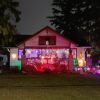Today’s featured photo of the day! The feature is: Radio
For the month of November, I will be featuring radio transmitters and antennae. Here is today’s featured photo, to commemorate with the industry of radio’s 100th anniversary of invention.. Here is a photo of a view of the Chicago skyscraper landscape with a night-cast sunset in the background on a summer evening from Navy Pier at a point near the 2/3 out point at the ChicagoFest event in the summer of 1982. The John Hancock Center, newly named 875 North Michigan Avenue (building) no longer has any large high-powered radio stations, but still has some lower powered stations and back up transmission for if the Willis (Sears) Tower’s transmissions are interrupted, transmitting on one of the two antennae. WDRV-FM 97.1, owned by Hubbard Broadcasting, moved on Friday, May 11, 2018 where the Bob Stroud mid-afternoon shift signed off in the John Hancock, rode down the street in a parade format while broadcasting during the move to the Prudential Building where they reside currently, thence transmitting from Willis Tower, and still simulcasts the signal to Zion station WWDV-FM 96.9. WDRV was the last high powered FM station to broadcast on a full-time basis from the John Hancock Center. The building abandoned a lot of continuing broadcasting when the price to maintain equipment and necessary upgrades in the television transmission to the digital area were not made.
Information that was relevant furnished, by Mark N., on an undisclosed “Group” on Facebook:
The following station still have their main transmitters at 875 N Michigan:
WBEZ Main and Aux
WXRT Main
WCHI Main and Aux
WCKL Main and Aux
WUSN Main and Aux
WSHE Main and Aux
WKQX Main and Aux
WVAZ Main and Aux
WOJO Main and Aux
The WDRV main transmitter is in the Aon building.
All these stations are Class B 50,000 watt equivalent, operating with power reductions according to their antenna heights, the maximum power allowed.
 1 · Like · Reply · More · Nov 12 at 12:11 PM
1 · Like · Reply · More · Nov 12 at 12:11 PM
Radio was initially invented in 1895 by the shared 1909 Nobel Prize Guglielmo Marconi– an Italian inventor and electrical engineer, in the honor of physics (with Karl Ferdinand Braun). In the early years was developed experimentally the years 1905–1906 for transmission of talk, news and musical content, and in 1920 commercially available amplitude modulating stations started out broadcasting on the still unchanged AM band. In the late 1920’s, Edwin Armstrong invented frequency modulation and VHF stations started broadcasting in 1936 and commercially in 1940. The original FM band which was located between 42 to 50 MHz, and it was found that there was still of tropospheric and Sporadic E propagation, so in 1946 FM was moved to the current frequency band of 88-108 MHz. The original FM bandwidth was re-assigned to non government fixed and mobile plus original television’s start of channels 1-6, and channel 1 (44 to 50 MHz) was the end part of that frequency, still having quality issues whereby the channel was abandoned nationwide and never utilized in other countries. The original VHF Low TV band (50 MHz to 88 MHz) was located jut below FM from 1946 to 2009. Channel 6, depending on the city, has a sound channel that is on either of 87.7 or 87.9, depending on which main city guidelines are in use. These sound channels have still been used to show up at the beginning of most FM receivers as FM stations 87.7 or 87.9, but have until July 13, 2021 to figure out a digital plan to succeed continuing transmission, or cease completely as analog is being phased out completely for the original channel 6. FM practices the same selection whereby each main city is off by .4 MHz, so the cities can have the same amount of stations and the stations do not “bleed” over each other. All FM radio stations in the U.S. always broadcast on an odd 10th of a frequency (100.3, NOT 100.2 or 100.4). Originally commercial stations used to start out with 93.1 MHz all the way up to 107.9 MHz, and educational and not-for-profit radio was 88.1 to 92.9 MHz. The FCC has still likes to issue these frequencies as being con-commercial, but exceptions have been known to emanate. Each market has 16 high powered stations and and equal portion of low powered stations on the in-between frequencies. The main stations are spaced exactly .8 MHz apart with low powered stations smack dab in the middle of the two high powered stations. Each market is spaced apart by .4 MHz to allow stations not to bleed. The FCC allows exceptions based on antennae being transmitted in a directional fashion, per station results. More to follow on history in the next article . . .
Photo taken with a tripod mounted Nikon FE camera through a Vivitar 70-150 zoom lens zoomed in at 150 mm, filter=polarizer, Aperture=2.8 f/stop, shutter-speed 1/2th second, loaded with Konica ISO (ASA) 100 Color 135-20 Negative Film processed with C-41 Processing Chemicals, and a Type C Print using the RA-4 enlargement paper process, onto a 4X6″ semi-gloss print. Date – August 1982.
Another fine photograph and facts about the John Hancock Center to follow very soon to celebrate the anniversary of radio!!
Anniversary of Radio Post: Celebrating The 100th Anniversary of Radio
PHOTO OF THE DAY
© 2020 Versatileer







One thought on “Featured Photo: Celebrating Radio’s 100th Anniversary: The Early Years – John Hancock Center in 1982”